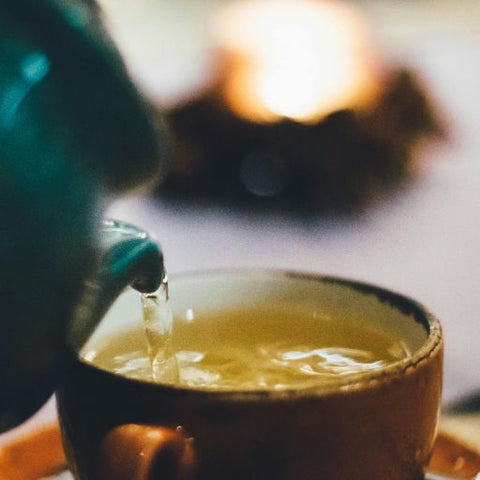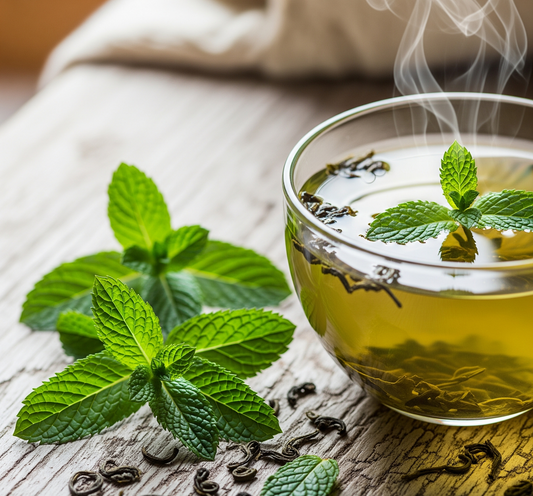Green tea, particularly Himalayan green tea, is celebrated for its unique flavor and numerous health benefits, including enhanced mental alertness and weight management. Grown in the high-altitude regions of the Himalayas, this minimally processed tea boasts a rich antioxidant profile. Explore the distinct qualities and advantages of Himalayan green tea to elevate your wellness journey and savor its delightful taste.
Green tea is one of the most famous types of tea in the world. Aside from the numerous health benefits claimed by WebMD, like improved mental alertness, digestive health, and weight management, green tea is also well-regarded for its unique aroma and flavor profiles. One such type of green tea that has managed to capture the world’s attention is the Himalayan green tea. In this blog, we’ll explore what makes Himalayan green tea so special, what sets it apart from standard green tea, and explore some of its top benefits.
So grab your favorite mug, and let’s embark on this flavorful journey together!
What is Himalayan Green Tea?

Himalayan green tea or Nepalese green tea is a type of green tea that is cultivated in the high-altitude regions (between 4,000 to 6,000 feet) of the Himalayas, especially Nepal and Darjeeling. This tea is noted for being one of the least oxidized varieties. The unique climate and rich soil contribute to the tea's distinct flavor profile and higher antioxidant and polyphenol content. Unlike other types of teas, Himalayan green tea tends to be minimally processed, allowing it to retain its natural flavors and health benefits.
This might beg the question, “How is Himalayan green tea different from regular green tea?” Well! Himalayan green tea differs from standard green tea primarily in its origin, flavor profile, and some unique health benefits associated with the specific environmental conditions of the Himalayas.
Let’s explore some of these differences in more detail.
The Geographical Miracle

Nepal has a unique climate and geography that contribute to the exceptional quality of its teas. The higher altitudes provide cooler temperatures, especially at night, which helps preserve the delicate flavors while allowing for robust growth during the day.
Most of the nation’s tea farms are located on top of a unique geographical formation and mountain range called the Siwalik Rock Formation. This one-of-a-kind formation makes the soil rich in minerals like mica, calcium, and magnesium which are absorbed by all the plant lives on top of it. This phenomenon helps create a unique nutrient and flavor profile that all Nepalese teas are so famous for.
Nepalese green teas often feature a smooth texture and complex flavor profiles that can include hints of fruit, floral notes, and even spices. These teas are not just flavorful; they also carry a sense of place that reflects their mountainous origins.
The Flavor Profile

When you take your first sip of Himalayan green tea, you will notice its mellow flavor and hints of smooth, floral, and grassy notes with a slightly bitter edge. This delightful combination makes it a refreshing choice that’s perfect for any time of the day. It typically also has a light, silky texture with a hint of sweetness.
Regardless of whether you prefer it hot or cold brewed, Himalayan green tea offers a highly soothing experience that never fails to recharge your spirit and brighten up your day.
In comparison, flavor notes of standard green tea can vary widely depending on the type; for example, Japanese green tea may offer a more umami or taste a bit like seaweed, while Chinese varieties might have a more nutty or sweet flavor profile due to its processing methods.
The Processing Techniques
As mentioned, both teas are minimally processed to maintain their unique green color and health benefits. However, Himalayan green tea is noted for being one of the least oxidized varieties. As Swadeshivip mentions, this minimal oxidation helps in preserving its high levels of antioxidants and polyphenols.
Standard green tea undergoes slight variations in processing; for example, some types of green tea like the Japanese Sencha are steamed. Similarly, other types of green tea like the Chinese Longjing are pan-fried which may affect their flavor and aroma.
Read more: Everything You Need To Know About the Types of Green Tea
Caffeine Levels
Himalayan green tea tends to typically have a lower caffeine content compared to many standard green teas. This is partly due to the specific cultivars and growing conditions found in the Himalayan region, which can influence the caffeine levels in the leaves. In general, a cup of Himalayan green tea typically contains anywhere from 30 to 50 mg of caffeine.
In comparison, standard green teas, especially those from regions like China and Japan, can have varying caffeine levels depending on the processing methods and specific types of tea. Some standard green teas may contain up to 70 milligrams of caffeine per cup, depending on their origin and how they were prepared.
Benefits of Himalayan Green Tea
Now, that we know what Himalayan green tea tastes like and how they are different to standard green tea, let’s explore why you should consider incorporating it into your daily routine. Here are some of the standout benefits that make it a must-try:
- Rich in Antioxidants: This tea is packed with antioxidants, which may help combat free radicals in your body. According to research on SpringerOpen, green tea was found to have the most anti-oxidant activities of all teas. These valuable compounds may reduce oxidative stress and lower the risk of chronic diseases.
- Aids Weight Loss: If you're looking to shed a few pounds to help you attain your desired weight, Himalayan green tea can be one of your most trusted ally. It is known to boost metabolism and aid in fat oxidation, making it easier to reach your weight loss goals.
- Enhances Brain Function: The caffeine content in Himalayan green tea may improve alertness and cognitive function without the jitters associated with coffee. Furthermore, it contains L-theanine, which has been shown to promote relaxation while enhancing focus.
- Aids Digestion: Sipping on Himalayan herbal tea after meals can assist in digestion and alleviate gastric discomfort. According to functional GUTCLINIC, green tea populates healthy bacteria in the intestines assisting digestion.
Why Organic Himalayan Green Tea: A Healthier Choice
When exploring Himalayan green tea, consider opting for organic Himalayan green tea varieties. Organic Himalayan green teas are grown without the use of synthetic pesticides or fertilizers, ensuring that you’re sipping on a cleaner and purer product. Organic farming practices also contribute to better soil health, facilitate biodiversity, and improve sustainable practices.
Brewing the Perfect Cup
Finally, if you’re convinced to try some Himalayan green tea, we have listed down a few simple steps to help you prepare a delightful cup:
- 1 teaspoon of loose-leaf Himalayan green tea
- 1 cup of fresh water
- Boil water until it reaches around 160°F. Avoid boiling water as it can scorch the leaves.
- Add the loose-leaf tea to your cup.
- Pour the hot water over the tea.
- Steep for around 3 minutes for optimal flavor.
- Remove or strain the leaves and enjoy!
Bonus Tips for Enjoying Your Tea
- Experiment with steeping times to find your preferred strength. Longer steeping time can strengthen the taste of the tea. However, it can also increase the bitterness.
- Add a splash of lemon or honey for tangy and interesting flavors.
In conclusion, exploring the magical world of Himalayan green tea opens up a realm of flavors and health benefits that can enhance your daily routine. From its rich antioxidant content to its ability to support weight loss and improve brain function, this delightful beverage has something for everyone. Whether you choose organic varieties or traditional blends, each cup offers a taste of the majestic Himalayas.




